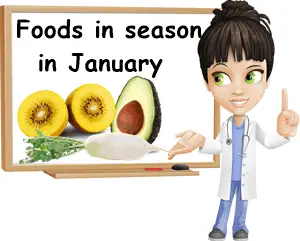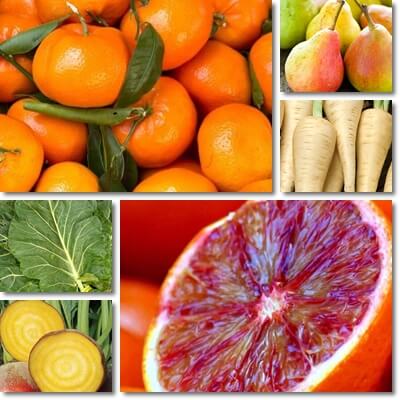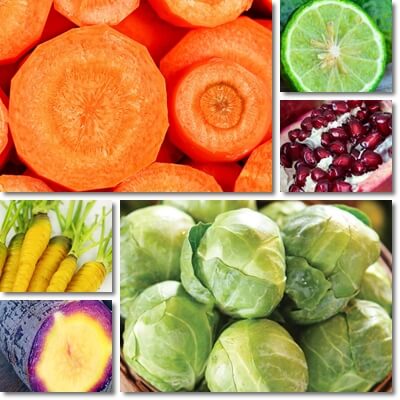Eating what’s in season is both healthy and accessible price-wise. Not to mention easier since seasonal foods, fruits and vegetables, are more readily available. And contrary to popular belief, there is quite a lot of variety to seasonal foods, whether it’s foods in season in spring, summer, autumn or winter. January in particular is a rich month when it comes to fruits and vegetables in season, and they’re all surprisingly healthy.
Foods in season in January are often times rich in anticancer agents, and good sources of anti-inflammatory compounds, potassium and vitamins C and K. Red beets, but also parsnip, turnip and carrots are rich in antioxidants and have anticancer properties. Greens such as Brussels sprouts, beet greens, green cabbage, leek, Swiss chard and turnip tops have anti-inflammatory and depurative properties, and a low glycemic impact.
Jerusalem artichoke and regular potatoes also feature on the list of seasonal January foods with benefits for high blood pressure and energy metabolism. Discover below a comprehensive list of seasonal January fruits and vegetables and find out what are their biggest benefits for health.

#1 Avocado
Avocado is a fruit, a berry to be more exact. It’s rich in healthy unsaturated fat and contains compounds called phytosterols, such as beta-sitosterol, with benefits for lowering high cholesterol.
#2 Bananas
Bananas have a high content of the mineral manganese which helps prevent bone loss and loss of cartilage, and boosts fertility. Bananas are also high in vitamin B6 which helps produce hemoglobin and boosts the capacity of hemoglobin to absorb oxygen, actively helping combat anemia.
#3 Beets (beetroot)
Beets naturally contain nitrates that get converted into nitric oxide following digestion. Nitric oxide relaxes and dilates blood vessels for better blood flow and lower blood pressure numbers. Beets also contain betalain pigments with anticancer properties.

#4 Beet greens (beet tops)
Beet greens are the leaves of beetroot, also called beet tops. You can eat the young leaves raw, and cook the older leaves and eat them as you would spinach. Beet greens are a good source of vitamins C and K with anti-inflammatory effects and have a depurative action.
#5 Broccoli
Raw broccoli is a good source of vitamin B9 (folate) with benefits for pregnant women. Vitamins C and K in broccoli are good for teeth health, support the immune system function and reduce markers of inflammation in the body.
#6 Brussels sprouts
Brussels sprouts are an anti-inflammatory food with depurative properties, helping cleanse the body and relieve constipation. Brussels sprouts boost good gut bacteria populations and energy levels via organic sulfur compounds and good amounts of vitamins B1, B2, B6, B9, non-heme iron, and vitamin C for better iron absorption.
#7 Cabbage
Raw cabbage provides vitamin C for better immunity and lower inflammation levels. Cabbage is also high in vitamin K with additional anti-inflammatory benefits and benefits for blood coagulation. Raw, cooked and pickled cabbage boost gut health and help grow populations of good gut bacteria.
#8 Carrots
Orange carrots are rich in beta-carotene with benefits for visual acuity, and provide immune system support. Yellow carrots have lutein and zeaxanthin for retina health, and lower risks of cataract. Purple and black carrots are rich in anthocyanin antioxidants with anticancer properties. White carrots contain the anticancer agents falcarinol, farcalindiol, methyl-falcarindiol and panaxydiol.
#9 Cauliflower
Orange cauliflower is rich in carotenoid antioxidants that provide benefits for eyesight and reduce risks of cataract. Purple cauliflower has anthocyanin antioxidants with scientifically proven anticancer properties. Green cauliflower is high in vitamin K and chlorophyll.
#10 Celeriac (celery root)
Celeriac is high in vitamin K and phosphorus with benefits for bones and teeth – while vitamin K regulates calcium metabolism, phosphorus actively contributes to bone formation.
#11 Chard
While chard is generally regarded as a winter vegetable, its main season is spring-summer, roughly April-May through June-July-August. A second season for chard is fall-winter, roughly October through April. Chard is very low in calories, only 20 kcal per 100 g, which makes it an ideal food for weight loss diets. High in non-heme iron, chard helps combat tiredness and fatigue.
#12 Chicory
You can eat chicories both raw and cooked, in salads, as a side dish or stuffed with rice, meat or vegetables. Because they are bitter tasting, chicories are good for digestion. Belgian endives are very low in calories, only 17 kcal per 100 g, and are good for weight loss.
Radicchio is similarly low-calorie, and an extreme source of vitamin K with anti-inflammatory benefits and benefits for bones and teeth.

#13 Clementine
Clementines are tangors, hybrids of the common sweet orange and mandarin oranges. In season November through January, clementines are refreshing and tonic, not to mention high in vitamin C. They are good for teeth health and lower levels of inflammation in the body. See more benefits of clementines.
#14 Collard greens
Collard greens, or collards, are available year round, but naturally in season January through April, which is when they taste their best. Collards are good for eyesight, skin health and the immune system, and high in manganese which prevents bone loss and loss of cartilage, and boosts fertility.
#15 Daikon radish
The Daikon radish is a variety of white winter radish originally from Asia. The winter seasonal root vegetable is a source of potassium and magnesium with benefits for high blood pressure, and contains natural organic sulfur compounds with anticancer properties. See more benefits of Daikon radish.
#16 Dried cranberries
Natural cranberry season runs October through November, but the tangy red berry-like fruits are available all of December, January and onwards as dried fruits. There are quite a few benefits to eating dried cranberries, including getting your fill of potent antioxidants and dietary fiber for digestive health.
#17 Fennel
Bulbous fennel, best known as Florence fennel, is in season fall through winter, and well into early spring. In addition to a delicate sweet taste with anise, dill and licorice notes, fennel provides only 31 kilocalories per 100 g which recommends it dearly for weight loss diets. The bulbous winter seasonal is a source of digestive benefits, exerting mild carminative effects.
#18 Grapefruit
Grapefruit is available year-round, with peak season being fall through winter and well into spring. This makes January a great month for grapefruit. The bitter flavors of the citrus variety recommend it as a digestif, stimulating bile production for optimal digestion. Grapefruit is high in vitamin C and good for skin, teeth and gums and the immune system.
#19 Jerusalem artichoke
Jerusalem artichoke is in season late fall through winter and up until early spring, depending on the region it’s grown in. The tuberous winter seasonal is a good source of potassium with benefits for high blood pressure and high in iron which combats fatigue.
#20 Kale
A serving of 100 g of cooked kale has 4 times the recommended daily intake of vitamin K, 50% vitamin C and 20% manganese. The seasonal winter vegetable has anti-bleeding effects, supports the immune system, lowers inflammation levels in the body, reduces risks of osteoporosis and boosts fertility.
#21 Kiwifruit
Kiwifruit is available year-round, including in January. Kiwifruit is naturally high in vitamin C and stimulates the production of collagen in the skin for better skin elasticity and antiaging benefits. Zespri SunGold golden kiwifruit is more than 50% higher in vitamin C than green kiwifruit, but green kiwifruit and kiwi berries are higher in vitamin K.
#22 Kohlrabi
Kohlrabi is a pale green or purple bulbous vegetable with crisp, rather bland white flesh. While it’s available year-round, it’s naturally a cool weather crop in peak season fall through spring. You can eat kohlrabi raw and get a high amount of vitamin C with anti-inflammatory benefits for skin. Kohlrabi also has blood pressure-lowering effects.
#23 Kumquat
Kumquat fruit, or cumquat, is an orange-like citrus fruit about the size of an olive. The bright orange citrus fruit is harvested November through January and December through April, depending on the variety and regions, but it’s a seasonal winter fruit. Kumquats are high in vitamin C, iron, magnesium and manganese and contain lutein and zeaxanthin antioxidants.
#24 Leek
Leek looks like a giant spring onion, but it’s milder tasting and just as healthy. Leek has a good content of vitamins B6, B9 and iron and provides benefits for anemia, supporting the production of red blood cells and boosting vitality. Eating leek is also good for pregnancy, helping prevent neural tube defects.
#25 Lemons
Lemon trees actually produce fruit year-round in warm climates which is why lemons are also available in January and all of winter. Lemons have a good content of vitamin C with benefits for for gums and teeth health, and have anti-inflammatory effects. However, lemons are high in organic acids which makes them one of the foods to avoid in gastritis.
#26 Limes
Limes are available year-round, but June through January is a great season for them. While not very nutritious, limes are a good source of vitamin C with anti-inflammatory, antioxidant and antiaging properties.
#27 Mango
With two seasons in the northern hemisphere and southern hemisphere, mango fruit are available year-round, including in the month of January. Mangoes have a good content of vitamin C with antioxidant, anti-inflammatory and antiaging properties. They are also a good food to eat for pregnant women thanks to their good content of vitamin B9.
#28 Mandarins
Peak season for mandarins is December through January. Mandarins are easier to peel than oranges and separate into segments easily, making a great snack. They are a good source of vitamin C and contain small amounts of pro-vitamin A, vitamins B1, B5, B6 and B9, potassium, magnesium and phosphorus.
#29 Onions
Onions are in season year round, but in colder regions, they are harvested in fall and stored for use throughout the winter months and well into spring. Onions have prebiotic effects, helping feed and grow good gut bacteria populations for good gut health. Onion are also an anticancer food.
#30 Oranges
Orange as an umbrella terms includes regular oranges, blood oranges, navel oranges, Cara Cara oranges and many more varieties. While available almost year-round, oranges are regarded as true winter fruits, with most varieties being in season November through April. Oranges provide much needed vitamin C during winter to help with immunity and support health teeth and gums.
#31 Parsnip
Parsnip contains chemicals such as falcarinol, farcalindiol, methyl-falcarindiol and panaxydiol with scientifically proven anticancer properties. Regular consumption can help lower blood pressure and is good for pregnant women, supporting the normal development of the baby during pregnancy.
#32 Pears
Plenty of late-fall pear varieties store well and can be made available all of winter and spring. January in particular is a great month for pears. The fruit has mild anti-hypertensive benefits and a low allergenic potential, and provides good amounts of copper and dietary fiber.
#33 Persimmon (kaki fruit)
October through January is a great time to eat persimmon fruit, or kaki. In season fall and winter, persimmon looks like a tomato and tastes like mildly sweet fruit pudding. It has a good content of vitamins C and B6, and the antioxidant manganese. The seasonal fruit is also high in pro-vitamin A antioxidants, and lutein and zeaxanthin with benefits for eyesight.
#34 Pineapple
Pineapple is technically in season year-round. Main season is June-July-August-September, but there’s another pineapple season December through February-March. Pineapple is a great source of vitamin C and manganese and lowers levels of inflammation in the body, helps prevent bone loss and loss of cartilage, lowering risks of osteoporosis, and boosts fertility.
#35 Pomegranate
Pomegranate is naturally in season September through November in the northern hemisphere, but fruits that store well are available well into winter, including January. Studies reveal a compound derived from pomegranates, Urolithin A, exerts antiaging benefits at cellular level by stimulating mitochondria recycling.
#36 Pomelo
While available year-round from different regions of cultivation, pomelo is naturally in season in the winter months, with peak season being December, January and February. Faintly bitter and not acidic like most other citrus fruit, pomelo is good to eat if you have gastritis or acid reflux. Pomelo is a good source of vitamin C.
#37 Potatoes
An off-season vegetable, but available in January, potatoes are moderate to high glycemic index and raise blood sugar levels. But potatoes are also good sources of dietary potassium and have mild blood pressure lowering effects. They further provide good amounts of vitamin B6 which helps produce hemoglobin and boosts the capacity of hemoglobin to absorb oxygen, actively helping combat anemia.
#38 Quinces
Quinces are naturally in season October though November, December at the latest. However, they can be found in supermarkets and farmer’s markets all of January too. In part, this is because they store extremely well and part of the crop is often saved for sale later on in winter. Cooked quinces are a good food to eat for anyone with digestive issues such as gastritis, peptic ulcer, acid reflux disease, or GERD.
#39 Rutabaga
The rutabaga is a type of turnip-like vegetable in peak season fall through winter. It’s a good source of vitamins B1, B3, B6 and B9, magnesium, manganese, phosphorus and potassium and lower glycemic than potatoes. You can make rutabaga fries to substitute French fries or roasted mashed rutabaga instead of mashed potatoes.
#40 Strawberries
January through November, strawberries are in season. While this is not a natural growing season for the fruit, strawberries are so popular that they have been picked up for cultivation everywhere that was possible, resulting in the fruit being available year round. January is the start of one of the many strawberry seasons and while the fruit is not quite as tasty as if it were grown in summer, it provides excellent amounts of vitamin C and good amounts of manganese.
#41 Sweet potatoes
Orange fleshed sweet potatoes are high in beta-carotene with benefits for eyesight and the immune system. Purple fleshed sweet potatoes contain anthocyanin antioxidants with scientifically proven anticancer properties. Sweet potatoes with pink and red flesh contain carotenoids with benefits for vision and immunity. You can even eat sweet potato leaves.
#42 Tangelo
The tangelo is a cross between a mandarin orange or a mandarin orange hybrid, and a pomelo. Tangelos are somewhat bell-shaped, lower-acidity than regular oranges and quite sweet. December through January is peak season for tangelos and juicy varieties such as Minneola and Orlando are international favorites. Better for acid reflux than common sweet oranges, and a good source of vitamin C, tangelos make a great snack as they are.
#43 Tangerine
The tangerine or tangerine orange is a hybrid of the mandarin orange. Tangerine season starts November-December and extends till May. Tangerines have better flavor than regular sweet oranges and are less acidic, and flattened at the top and base. They are a good source of vitamin C with anti-inflammatory benefits and boost collagen production for better skin elasticity and fewer wrinkles.
#44 Turnip
Turnips are in season October through March. The roots are modestly nutritious with good amounts of vitamin C and low in calories. Turnip leaves are rich in vitamin K and help lower risks of osteoporosis and cardiovascular disease. The leaves are high in the antiaging vitamins A, C and E and a good source of vitamin B9.
#45 Walnuts (dried)
Walnuts are naturally in season October through November, but are available as dried fruits January and onwards. Walnuts are an excellent source of the antioxidant mineral manganese which helps prevent bone loss and loss of cartilage, and boosts fertility. Eating walnuts boosts energy levels with B vitamins and provides long-term satiety thanks to a high content of fat.
#46 Winter apples
Although the name is not quite accurate, winter apples are either varieties of fall apples that store really well over winter, or come from the southern hemisphere. The so-called winter apples can last well into spring and include varieties such as Ashmead’s Kernel, Baldwin, Black Twig and Braeburn apples, Fuji, Gala, Golden Delicious, Honeycrisp, Idared, Melrose and Mutsu apples, Pink Lady, Rome apples, Staymans apples and many more.
#47 Yams (not sweet potatoes)
Yams are a source of good nutrition and benefits for health. They are high in potassium with blood pressure lowering properties, and have benefits for high cholesterol. Yams are a generous source of manganese with benefits for osteoporosis, but need to be cooked to render them edible.
